

Wildflower Week


WELCOME TO WILDFLOWER WEEK!
Every summer, the countryside in Willistown explodes with a symphony of nature. The sounds of buzzing bees and birds calling fill the colorful blooming landscape. We are fortunate to have this ample open space packed with such a rich diversity of flora and fauna, yet global populations of insects and birds continue to drop. Native wildflowers are an essential food source for pollinators and birds, and the small pockets land still supporting this habitat are not providing enough to be sustainable. More than ever, each of us must do all we can to support nature at home and in our community.
At Willistown Conservation Trust, we are committed to supporting this effort through public programming and education. With our Lawn Conversion Program, we are able to help public and private landowners transform mown lawns into high quality meadow habitats by subsidizing the cost of installation using funds from the Pennsylvania Department of Conservation and Natural Resources. And at our brand new Kestrel Hill Preserve, we have begun the process of transforming 25 acres of fallow cornfields into native grasslands and wildflowers.
All the while, we are translating the importance of this work to the community through continued education, collaboration, and conversations.
This year, we invite you to join the cause and be inspired by exploring the countryside at our nature preserves. Whether it’s Kirkwood’s sweeping grasslands, the diverse ecosystems at Ashbridge, Rushton’s robust rain garden, or the beauty of Hartman Meadow, our land is home to a wonderful variety of native wildflowers. So stop and listen to the birds and bees, smell the fragrance in the air, brush your fingertips against the tall grasses, and delight in all the nature there is to enjoy.
RUSHTON WOODS PRESERVE & FARM
1 2 3 4
WOODPECKER WOODS PRESERVE

WILDFLOWER WEEK SELF-GUIDED TOUR MAP & LOCATIONS
1 2 3 4
Hartman Meadow
Willistown Conservation Trust (WCT) Office
925 Providence Road, Newtown Square
Pick up your free wildflower seed packet here!
Rain Garden & Foundation Garden
Rushton Conservation Center 915 Delchester Road, Newtown Square
Native Shade Garden
Entrance to Rushton Farm Area
911 Delchester Road, Newtown Square
Rushton Farm Wildflower Meadow
Rushton Farm, crop fields near hedgerow
911 Delchester Road, Newtown Square
OUR PRESERVES
Ashbridge Preserve
1691 E. Strasburg Road, West Chester
Over 125 native trees and shrubs were planted as part of a streamside buffer restoration project along the west bank of Ridley Creek.
Kirkwood Preserve
855 Grubbs Mill Road, Newtown Square
Over 600 native trees and shrubs have been planted along Crum Creek and Massey Run within Kirkwood Preserve. To view this area, see the map in the kiosk.
Rushton Woods Preserve & Farm
911 Delchester Road, Newtown Square
The lush woodlands of Rushton Woods Preserve are an excellent space to gather ideas to create your own shade garden. In the spring, native ferns, including Northern maidenhair ferns can be seen along the trails throughout the woodland.
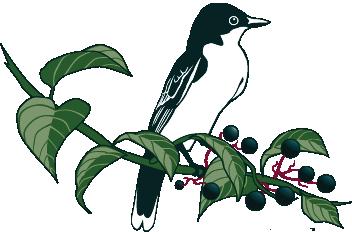



SEEDING AT KESTREL HILL PRESERVE
By John Holback, Stewardship Manager
In early 2024, Willistown Conservation Trust (WCT) purchased a 90-acre parcel of land between Plumsock Road and Providence Road to establish a public preserve. Mostly open rolling hills, the land had been a passively managed wildland except for 25 acres of agricultural fields. The empty, mostly weed free ag fields offered the unique opportunity for WCT to convert the land to something more ecologically valuable with minimal effort.
Historically, open spaces in our region were created and maintained by lightning-caused fire, disturbance by indigenous peoples using fire to manage the land, and before that, megafauna like mammoths, ground sloths, and many others. Nowadays, most grasslands and meadows have an agricultural past and are dominated by non-native, cool-season grasses intended to be planted and used for animal fodder. Without regular disturbance (fire, mowing), these grasslands will quickly fill in with woody cover (trees, shrubs) and will no longer serve the species that have adapted to rely on them. And without active management like establishing native grassland plants and removing non-native ones, they will remain relatively low quality ecosystems dominated by non-native grasses.
Establishing a native grassland starts with removing undesirable plant species and then planting desirable ones. Modern no-till-drills, a type of agricultural equipment, allow land managers to plant lots of seed over large areas quickly and with minimal soil disturbance. Planting this way ensures the seeds have good soil contact, minimize erosion, and hides the seed from hungry birds and small mammals. Since the ag fields at Kestrel Hill were already plant free, WCT opted to rent a no-till-drill and seed the two former ag plots.
Two different seed mixes were planted, - one contained native grasses and forbs, the other just native grasses - along with a cover crop of oats. The cover crop’s purpose is to hold the soil in place, help prevent the establishment of undesirable plants, and provide some cover for the native seedlings. The ten-acre field adjacent to Providence Road features three native grasses and 24 different forbs, while the 15-acre field adjacent to Plumsock Road features four native grasses. Over the next few years, both areas will require regular mowing and spot treatments to prevent undesirable plants from establishing while allowing the native plants to get established and begin spreading.
Establishing grasslands does more than aid displaced plant and animal species. Grasslands sequester large amounts of carbon, helping to cool a rapidly warming planet. They build soil health and absorb excess stormwater. Healthy grasslands require little maintenance - only annual mowing or burning every few years and some small spot treatments for non-native weeds. Visitors will soon be able to enjoy the recreational offerings of WCT's new grassland preserve. Hiking and equestrian trails are already established and the views will only improve as the native plants grow and thrive.


HARTMAN MEADOW
It has been well documented that mowed lawn areas are typically a monoculture of non-native grasses, which require a great deal of time, water, and chemicals to maintain while providing little benefit to wildlife. In 2008, the Trust decided to create a one-acre demonstration wildflower meadow to highlight a simple, attractive, and sustainable planted alternative to a manicured lawn. With over 48 million acres of lawn in the U.S., in addition to studies indicating worrying declines in bird and insect species due to habitat loss, it is time to begin viewing our lawns as places where conservation can occur.
Native plant species provide cover and seeds for birds, act as nectar and food sources for butterflies, bees, and other insects, and offer aesthetic diversity through their varied colors and textures. Over time, native grass and wildflower species in a meadow generally out-compete the weeds, making the wildflower meadow far less maintenance-intensive than a pure lawn. The roots of established native plants reach deep into the earth, sometimes even mining groundwater, making a native meadow much more drought tolerant than a lawn. The establishment of these deep root systems can take 2-3 years, but the rewards are worth the wait.
To ensure the successful establishment of our meadow, we purchased about 800-1,200 landscape “plugs” (young plants) each year beginning in 2008, and planted them in manageable 20’ x 30’ plots, adding one new plot each year through 2017. In late April and early May, plugs were planted directly into the existing turfgrass by hand at a ratio of one per square foot; the turfgrass acts as a cover crop to discourage other weeds. Native grasses were incorporated as plugs or seeds into the plots along with the wildflowers. The plots are mowed only once annually, typically in late March/early April to provide food and cover for over-wintering bird species and other wildlife.
HARTMAN
MEADOW
-Virginia mountain mint
-Butterfly weed
-Leaved goldenrod

-Common milkweed
-Tall coreopsis
-Black-eyed susan
-Gayfeather
-Sunflower
-Purple coneflower
-Joe Pye weed
-Short-toothed mountain mint
-Culver’s root
-Poke weed
-Cup plant
PROVIDENCEROAD
-Bergamot
HARTMAN MEADOW | was named in February 2020 in honor of the previous Director of Stewardship, Bill Hartman for over thirteen years of service and dedication to Willistown Conservation Trust.
PERENNIALS











Joe Pye weed (Eupatorium fistulosum)
Swamp Milkweed (Asclepias incarnata)
Tall coreopsis (Coreopsis tripterus)
Culver’s root (Veronicastrum virginicum)
False sunflower (Heliopsis helianthoides)
Mountain Mint (Pycnanthemum muticum)
Wild bergamot (Monarda fistulosa)
Black-eyed Susan (Rudbeckia fulgida)
Cup Plant (Silphium perfoliatum)
Grass-leaved goldenrod (Solidago graminifolia) Pokeweed (Phytolacca americana)
Photos: Blake Goll/Staff, Kristen Henwood, Stephanie Kuniholm, Monica McQuail, Lady Bird Johnson, High Country Gardens, Missouri
Botanical Garden, Budburst, Gardenia.net, U.S. Forest Service, American Meadows, Cochato Nursery, Centerton Nursery, Gerris, and Wikipedia.
RUSHTON CONSERVATION CENTER RAIN GARDEN
The Rushton Conservation Center (RCC) driveway wraps around the Rushton Rain Garden, planted in 2018. Designed by Johnathan Alderson Landscape Architects, this garden features a variety of perennials, grasses, and woody plants carefully selected for their ability to withstand wet soils to help mitigate the stormwater runoff created by the paved driveway. Roadways, driveways, and sidewalks carry water to storm drains, which feed directly into our local waterways. This water can carry pollutants and debris like road salts, heavy metals from cars, and sediment that impacts the water quality. Increased development of impervious surfaces, or surfaces that water cannot seep through, can also lead to increased flooding because more water is carried to our streams through the storm drains.
Rain gardens are designed to intercept water and help return it slowly back into the ground while filtering out contaminants. They can have deep basins, like ours at the RCC, or the depression can be subtle. Our basin has a drain in the center for excess water during heavy downpours carrying the water downhill to a meadow where it will also slowly filter back into the ground.
The plants used in rain gardens, or other soggy areas in a garden, like to “have their feet wet.” Their deep root systems can withstand heavy rainfall over a short amount of time and through periods of drought. These plants can also be the perfect addition near downspouts and along driveways.
The Rushton Conservation Center Rain Garden was made possible by the generosity of Lida A. Wright.

Monica McQuail/Staff
PERENNIALS


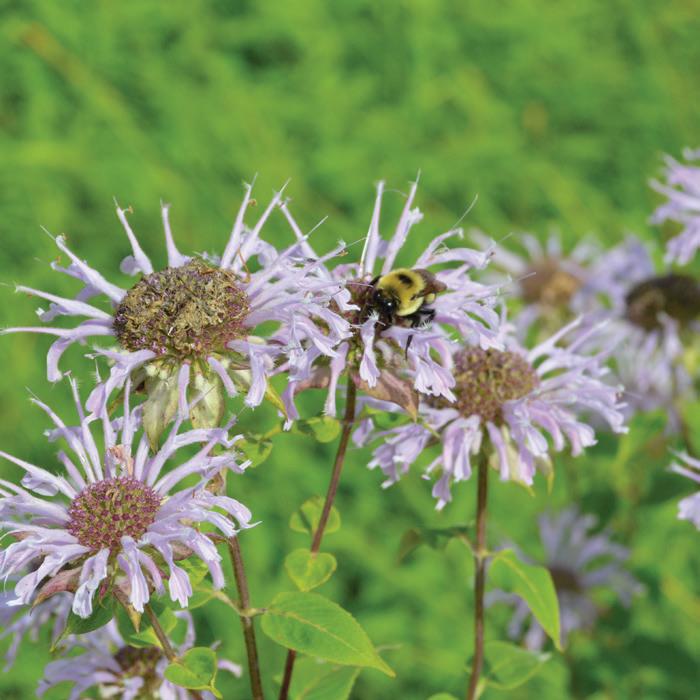






TREE
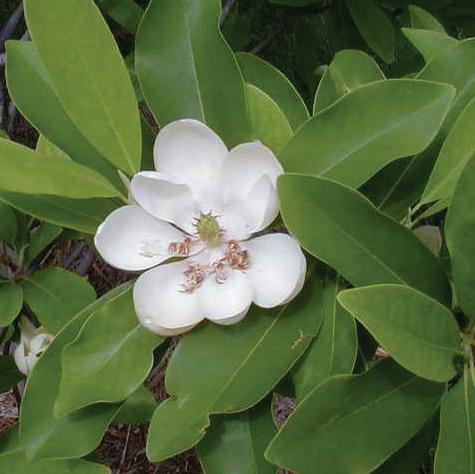
Butterfly weed (Asclepias tuberosa)
Aromatic aster (Aster oblongifolius)
Eastern beebalm (Monarda bradburiana)
Daisy fleabane (Erigeron strigosus)
Golden groundsel (Packera aureus)
Beardtongue (Penstemon digitalis)
Cutleaf coneflower (Rudbeckia laciniata)
Goldenrod (Solidago)
Carolina lupine (Thermopsis caroliniana)
Sweetbay Magnolia (Magnolia virginiana)
Photos: Blake Goll/Staff, Kristen Henwood, Stephanie Kuniholm, Lady Bird Johnson, High Country Gardens, Missouri
Botanical Garden, Budburst, Gardenia.net, U.S. Forest Service, American Meadows, Cochato Nursery, Centerton Nursery, Gerris, and Wikipedia.
RUSHTON CONSERVATION CENTER FOUNDATION GARDEN
The gardens surrounding the Rushton Conservation Center (RCC) and along the entrance drive were designed by Johnathan Alderson Landscape Architects and planted upon completion of the RCC in 2018. All of the gardens at the Trust’s office and preserves have been loosely planned, but the gardens surrounding the RCC exhibit the use of native plants in a more manicured way, maintaining a variety of textures and colors while attracting insects and birds.
These gardens also have our largest variety of trees, shrubs, and grasses with perennials scattered throughout. While the flowering plants offer a delightful palette of color throughout the year, several varieties of grasses provide complementary textures and colors ranging from silvery blues like the Bunny Blue sedge to bright greens like Blonde Ambition Grama grass.
While celebrating Wildflower Week, we thought you would also appreciate a look at these other options of native plants for your property.

Monica McQuail/Staff
PERENNIALS



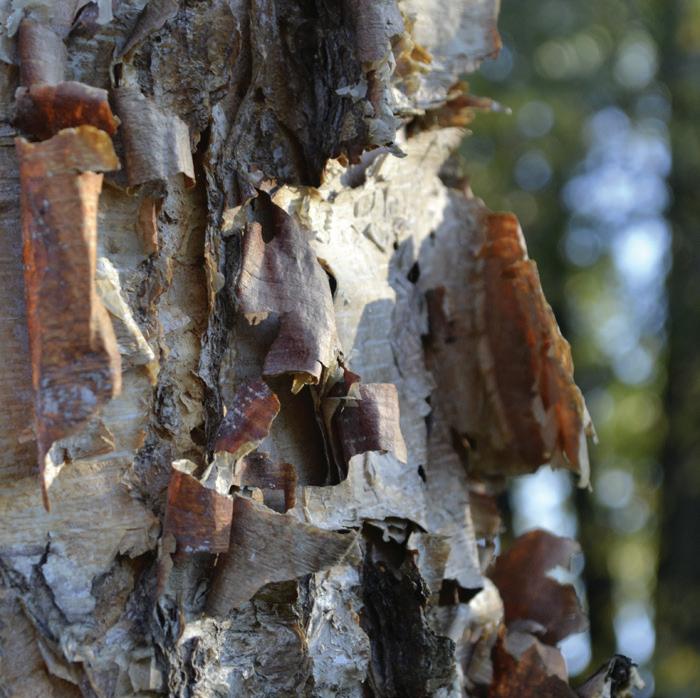

TREES & SHRUBS GRASSES




Yellow buckeye (Aesculus flava)
River birch (Betula nigra)
Winterberry holly (Ilex verticillata)
Blackgum (Nyssa sylvatica)
Coast Azalea (Rhododenron atlanticum)
Blazing star (Liatris spicata)
Cranesbill (Geranium maculatum)
Blue Grama Grass “Blond Ambition” (Bouteloua gracilis)
Little bluestem “standing ovation” (Schizachyrium scoparium)
Photos: Blake Goll/Staff, Kristen Henwood, Stephanie Kuniholm, Monica McQuail, Lady Bird Johnson, High Country Gardens, Missouri
Botanical Garden, Budburst, Gardenia.net, U.S. Forest Service, American Meadows, Cochato Nursery, Centerton Nursery, Gerris, and Wikipedia.
NATIVE SHADE GARDEN
This enchanting little garden changes throughout the seasons. The life cycle of a shade garden has several important stages including flowering, developing seeds for birds or insects, and decomposing. Some of the plants rise from the soil and tilt their faces to the sun, but the majority of the plants in this garden are for shade or part shade. Shade gardens can help fill gaps under trees and shrubs and add color to wooded areas while creating visual texture throughout all four seasons.
All of the plants bring their specialty to this habitat, providing seed or shelter for the birds, adding color in their flowers for us to admire, or offering a tasty morsel from their foliage to a chipmunk. The few plants that prefer a bit of sun are the Stoke’s Aster, Tickseed, and Northern Sea Oats, as you can see by their location being closer to the front edge of Delchester Road.

LandArt Events artist, Denise Vitollo painting in the Rushton Farm Shade Garden.
PERENNIALS








FERNS
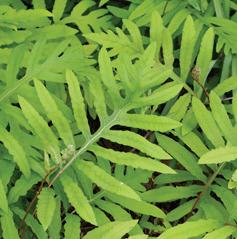

Christmas Fern (Polystichum acrostichoides)
Sensitive fern (Onoclea sensibilis)
Canada Anemone (Anemone canadensis)
Black Cohosh (Cimicifuga racemosa)
Leading Lady Charlize (Coreopsis auriculata)
Thread-leaf coryopsis (Coreopsis verticilata)
Beebalm ‘Jacob Kline’ (Monarda didyma)
Beardtongue (Penstemon digitalis)
Stoke’s Aster (Stokesia)
Wood poppy (Stylophorum diphyllum)
Photos: Blake Goll/Staff, Kristen Henwood, Stephanie Kuniholm, Lady Bird Johnson, High Country Gardens, Missouri
Botanical Garden, Budburst, Gardenia.net, U.S. Forest Service, American Meadows, Cochato Nursery, Centerton Nursery, Gerris, and Wikipedia.
RUSHTON FARM WILDFLOWER MEADOW
In the old days, farming was automatically performed in concert with nature. Hedgerows and wild “weedy” meadows next to farm fields were common, as the farm acted as part of the surrounding ecosystem. Now commercial agriculture is much more intensive and often involves clearing all surrounding habitat to make way for expansive farm fields; erosion, soil degradation, and chemical inputs ensue. Rushton Farm is an example of regenerative farming that aims to increase biodiversity, ensure the long-term health of the land, and enhance natural ecosystem services like pollination.
The wild meadows you see next to the working farm fields at Rushton provide habitat for a myriad of insects, including species that are predators to farm pests, as well as other species that promote pollination of the crops. Research shows that the wild pollination services of native bees and butterflies are twice as efficient as the supplemental services of managed honeybees. In other words, managed honeybees cannot replace wild insects in most cases. Therefore, farmers benefit immensely by adopting wildlife-friendly practices such as restoring patches of the natural landscape in their fields.
Our natural wildflower strips have been in place since the birth of Rushton Farm over 10 years ago. Although some perennial plugs were planted early on, it has largely been “let-go” and only mowed once a year in spring to prevent woody growth. Naturally occurring goldenrod and milkweed abound. This thick habitat not only supports beneficial insects, but also many bird species including migratory warblers and sparrows in search of cover and food when passing through in the fall.

Wildflower meadow in September. Photo by Blake Goll/Staff.
PERENNIALS









SHRUB

Common yarrow (Achillea millefolium)
Pennsylvania blackberry (Rubus pensilvanicus)
Common milkweed (Asclepias syriaca)
New England aster (Aster novae-angliae)
Purple coneflower (Echinacea purpurea)
Daisy fleabane (Erigeron annuus)
Common boneset (Eupatorium perfoliatum)
Short-toothed mountain mint (Pycnanthemum muticum)
Showy goldenrod (Solidago speciosa)
Photos: Blake Goll/Staff, Kristen Henwood, Stephanie Kuniholm, Lady Bird Johnson, High Country Gardens, Missouri
Botanical Garden, Budburst, Gardenia.net, U.S. Forest Service, American Meadows, Cochato Nursery, Centerton Nursery, Gerris, and Wikipedia.
Field thistle (Cirsium discolor)
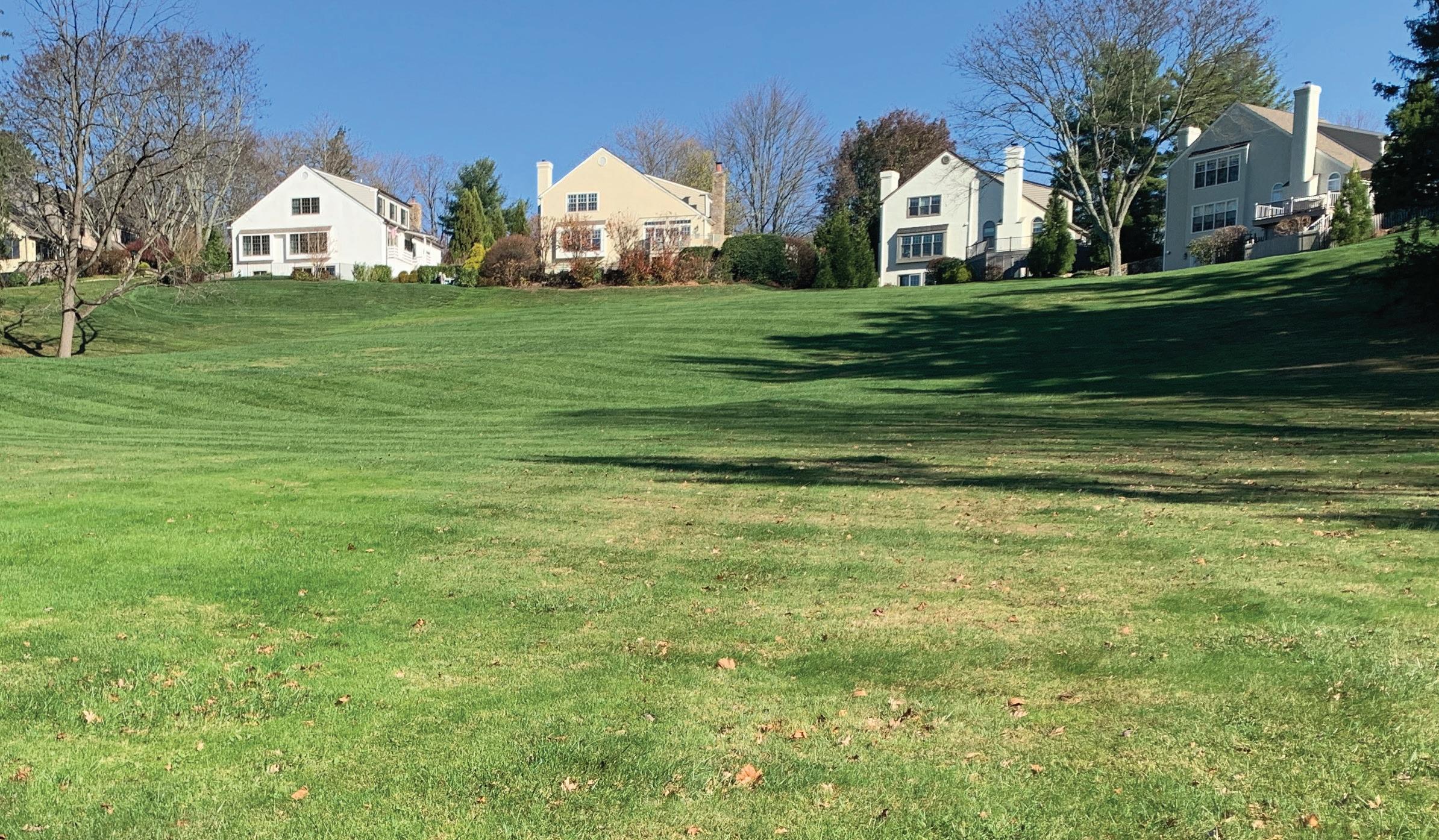
2023 2024



CONVERTING LAWNS TO MEADOWS
By Mike Cranney, Director of Stewardship
As you may have heard, the Trust has been working on an exciting project that transforms areas previously maintained as lawn into native meadows. With funding from the Pennsylvania Department of Conservation and Natural Resources (DCNR), our staff have been working throughout the area for over a year to partner with eligible landowners who want to participate in the program. Now, we have some exciting updates to share!
This spring, the work began to transform 27 acres of turf across 12 different properties into beautiful native grasses and wildflowers. We worked with a contractor who prepped and seeded each of the sites with a diverse meadow mix that includes species such as milkweed, black-eyed Susan, bergamot, mountain mint, oxeye sunflower, numerous asters and goldenrods, and many more. This fall, the process will be repeated on an additional 23 acres of lawn, providing the region with over 50 acres total of new habitat.
The transformation will not be immediate, as meadows take some time to get established. Before growing upwards to create blooms and seeds, these native species initially use their energy to form deep, robust roots. This will allow the plants to collect ample resources and hold the soil firmly in place. While things on the surface may be slow at first, the management during this time can be vital to the meadow’s long-term health. Representatives both from the Trust and the contractor will return to the sites to monitor progress, with any necessary follow up treatments for invasive species to be covered by the grant funding. We also have commitments from each participating landowner to conduct the mowing necessary to control unwanted woody plants that could out-compete the meadow species.
With all of this going on, word of the program has gotten out. We have been hearing from more and more landowners, including various homeowner associations, who want to get involved. Because of the additional interest, we are now planning to apply for another round of funding next year, which could allow us to continue the program and convert another 50+ acres of lawn. This process has expanded our reach and created new connections for the Trust, opening us up to new partnerships and opportunities. It has already been very rewarding, and we hope it will only continue to grow, so keep an eye out for more updates as the project continues!
If you are interested in learning more, contact the Trust’s Director of Stewardship, Mike Cranney (mjc@wctrust.org), or visit the PA DCNR website: https://www. dcnr.pa.gov/Conservation/Water/LawnConversion/Pages/default.aspx
NATIVE ALTERNATIVES TO INVASIVE SPECIES
For too long, gardeners and landscapers have fallen back on the same old standbys when it comes to plant selection. They pick from a limited pallet of non-native species which in turn becomes the selection we are forced to choose from at most nurseries and big box stores. And while many of these do admittedly have attractive qualities, they also frequently provide no value, and sometimes downright harmful, to local pollinators and wildlife.
Native plants support local wildlife better than exotic ones because they have evolved in the ecosystems where we live. The insects, pollinators, and birds developed life cycles that are dependent upon these particular species. Many insects (especially caterpillars, a vital food source for birds) will only live on one specific plant species (think of the monarch’s dependence on milkweed). And while you will see bees and butterflies visit non-native plants, these do not offer the same amount of nutritional content as their native alternatives. A blueberry, for example, is far more nutritious for a bird than a barberry. Birds have to eat more of the invasive species to get the same amount of benefits, which then compounds the problem as they spread more of the invasive seeds in their poop.
With a little research and careful selection, we can easily move away from invasive garden species to more beneficial natives. Here’s a list to get started, derived from the excellent book from the Brooklyn Botanical Garden, Native Alternatives to Invasive Species.


INVASIVE SHRUB: Japanese Barberry (Berberis thunbergii) escapes into the wild and invades forests where it pushes out native shrub species plus it is a vector for ticks; added to Pennsylvania’s noxious weed list in 2022
NATIVE ALTERNATIVES:
Witch Alder (Fothergilla gardenii)
• small shrub with rounded to mounding form.
• 3-5 ft tall and wide
• Fuzzy white terminal flower clusters in early spring
• Oval scalloped foliage
• Orange to burgundy fall color
New Jersey Tea (Ceanothus americanus)
Mounding to spreading form.
1-3 ft tall and 2-4 ft wide
Terminal white flower clusters in late spring and summer
Deep green foliage
Yellow autumn color
Bush honeysuckle (Diervilla lonicera)
See it at the RCC by the front door!
Small shrub with arching vase-like form.
2-4 ft tall and 3-5 ft wide
Yellow flowers all summer
Yellow to burgundy autumn color.
INVASIVE SHRUB: Butterfly Bush (Buddleja davidii) despite the name, butterfly bush only supports adult butterflies with its abundant nectar but fails to provide for all the other life stages.
NATIVE ALTERNATIVES:
Buttonbush (Cephalanthus occidentalis)
Rounded, irregular form
6-10 ft tall and wide
Attractive winter silhouette
Fuzzy white summertime flowers
Deep glossy green foliage
Yellow autumn color.
Summersweet (Clethra alnifolia)
Upright to irregular form
4-8 ft tall and wide
Tawny to chestnut-colored bark
Deep green quilted foliage
Spikes of sweet-scented white flowers in summer
Yellow autumn foliage color



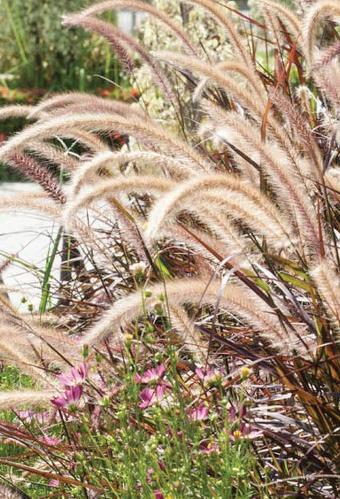
INVASIVE GROUNDCOVER: Japanese Pachysandra (Pachysandra terminalis)
Aggressive spreader, easily escapes into adjacent natural areas.
NATIVE ALTERNATIVES:
Allegheny spurge (Pachysandra procumbens)
Dense, slow-spreading
groundcover
Paddle-shaped evergreen leaves
Fuzzy spring flowers
Rich winter foliage
Not deer resistant!
Virginia creeper (Parthenocissus quinquefolia)
Climbing vine with holdfasts
Palmate leaves with five leaflets
Smoky-blue berries on red stalks
Flaming autumn color
Blue-eyed grass (Sisyrinchium angustifolium)
Deer resistant
Delicate blue star shaped
spring flowers
Grass like foliage
Grows in dense, tufted clumps
INVASIVE VINE: Japanese Honeysuckle (Lonicera japonica)
Aggressive vine that will smother trees and shrubs.
NATIVE ALTERNATIVE:
Trumpet Honeysuckle (Lonicera sempervirens)
Well-behaved deciduous vine
Scarlet flowers that attract butterflies and hummingbirds
Small red berries
Gray-green leaves
Exfoliating winter bark
INVASIVE GRASS: Chinese Silvergrass (Miscanthus sinensis)
Very aggressive and deep rooted ornamental grass that is sold as sterile but tends to reproduce anyway. A serious threat to meadows and natural grassy areas.
NATIVE ALTERNATIVE:
Indiangrass (Sorghastrum nutans)
Clumping grass with ascending, tufted foliage
Silky golden plumes
Red to russet autumn color
INVASIVE GRASS: Fountain Grass (Pennisetum)
Switchgrass (Panicum virgatum)
Clumping grass with an open, lacy form
Reddish-purple seed heads
Pale to bright yellow fall color
Escapes into natural areas forming dense stands, prolific seeder spreads by wind.
NATIVE ALTERNATIVE:
Pink hair grass (Muhlenbergia capillaris)
Clumping grass with a rounded crown
Low tufts of arching blades
Airy red plumes
Russet to tawny autumn color
Photos: Lady Bird Johnson, Gardenia.net, and WHYY.
NATIVE ALTERNATIVES TO INVASIVE SPECIES (Continued)





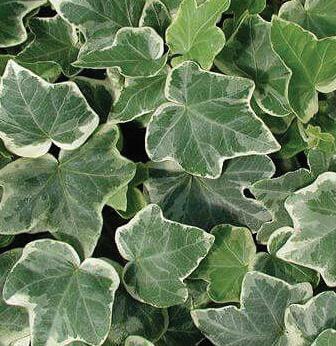
BAMBOO (Bambusa, Phyllostachys and Pseudosasa species)
Description: A popular plant for privacy screens due to its fast and dense growth habit, these species will quickly spread through underground rhizomes and can become out of control.
Alternatives: big bluestem (Andropogon geradii), indiangrass (Sorghastrum nutans), for privacy screens: eastern red cedar (Juniperus virginiana), arborvitae (Thuja occidentalis)
EXOTIC BUSH HONEYSUCKLES (Lonicera species)
Description: These species were introduced as ornamental specimens but have escaped into the wild and disrupted woodland habitats and hedgerows. The fruit is carbohydrate rich, which does not provide enough fats for migrating birds.
Alternatives: arrowwood (Viburnum dentatum), northern bayberry (Myrica pensylvanica), spicebush (Lindera benzoin), red or black chokeberry (Aronia arbutifolia or melanocarpa)
MULTIFLORA ROSE (Rosa multiflora)
Description: Introduced as an ornamental species in 1866, multiflora rose was later promoted for erosion control, as a living livestock fence, and wildlife cover by the government. It was eventually determined to be highly invasive, quickly outcompeting native shrubs in forests and other habitats.
Alternatives: common blackberry (Rubus allegheniensis), swamp rose (Rosa palustris), pasture rose (Rosa carolina)
PRIVET (Ligustrum species)
Description: Widely used for hedges and privacy screens, privet has invaded forests, floodplains, wetlands and fields throughout the Northeast. It forms dense thickets that outcompete native vegetation.
Alternatives: inkberry holly (Ilex glabra), spicebush (LIndera benzoin), blackhaw viburnum (Viburnum prunifolium), red or black chokeberry (Aronia arbutifolia or melanocarpa)
NORWAY MAPLE (Acer platanoides)
Description: Introduced as an ornamental species, Norway maple is highly aggressive and invades forests, fields, and many other habitats where it displaces native trees and shrubs. Alternatives: American beech (Fagus grandifolia), red maple (Acer rubrum), sweet gum (Liquidambar styraciflua), willow oak (Quercus phellos), black gum (Nyssa sylvatica)
ENGLISH IVY (Hedera helix)
Description: Commonly used as an ornamental groundcover, English ivy will escape into the wild and form dense impenetrable mats on the forest floor, woodland edges, fields, hedgerows, coastal areas and wetlands. This vine will smother and kill trees and harbors bacterial leaf scorch, a harmful pathogen that kills oaks, maples, and elms.
Alternatives: Virginia creeper (Parthenocissus quinquefolia) (caution should be used where planting as it can be quite aggressive), crossvine (Bignonia capreolata), wild ginger (Asarum Canadensis), lady fern (Athyrium filix-femina), maidenhair fern (Adiantum pedatum), foam flower (Tiarella cordifolia), hairy alumroot (Heuchera villosa)
Photos: Lady Bird Johnson, Gardenia.net, Eric Boyda
SUGGESTED READS & APP RECOMMENDATIONS
SUGGESTED READS



USEFUL APPS

iNaturalist | Provides species recommendations of plants, animals, and insects based on user photos.

The Cornell Lab Merlin Bird ID | Easy to use app to identify birds by size, main colors, and position in the landscape. Now includes sound ID that will record the birdcall and display likely species!

Seek by iNaturalist | Uses the camera in your phone to identify plants, animals, and insects in real time.



MIKE CRANNEY, DIRECTOR OF STEWARDSHIP
Upon joining us in 2020, Mike quickly got to work managing the Trust’s many acres of public land. Thanks to his Masters in Environmental Studies from the University of Pennsylvania and a background in gardening at Morris Arboretum, he has developed a passion for native plants and ecological restoration. He has passed on the value of good stewardship while working with our many volunteers, and aims to do the same throughout the community as he manages the Trust’s Conservation Easements held on private properties. When he’s not at the preserves, you can find Mike at the movies or watching Philly sports.
JOHN HOLBACK, STEWARDSHIP MANAGER
Having been raised in Landenberg and spending most of his formative years in the creek and woods around his home, John is a Chester County native. Before spending the last five years working in California’s Santa Cruz Mountains on a variety vegetation management projects designed to cultivate healthy ecosystems while combating the effects of extreme wildfire, John worked in the Wissahickon Valley Park building and maintaining multi use trails, planting trees, and leading volunteers. John and Emily, his wife, recently relocated to West Chester where she works as an Assistant Professor. In his free time, John likes to spend time with friends and family, cook, and use his metal detector to hunt for old relics.
BLAKE GOLL, EDUCATION PROGRAMS MANAGER
As the Education Programs Manager at the Trust since 2010, Blake Goll has developed the Trust’s Rushton Nature Keepers program and curriculum for children, as well as other various outreach education programs for all ages. She also assists with the daily operations of the songbird banding and owl banding stations throughout banding season, and provides outreach to help educate the community about conservation. Blake is a North American Banding Council (NABC) certified bird bander, and some of her favorite activities include doing yoga, gardening, hiking with my shepherd mix, reading, cooking, and interior designing!
WILDFL OWER MEADOW MANAGEMENT GUIDELINES

Not only are wildflowers beautiful to look at, they are extremely important for our native wildlife since they provide breeding and feeding grounds for many insects, mammals and birds. Many of our native species have evolved together and are subsequently interdependent for their survival. These management guidelines should help you maintain your wildfl ower meadows to maximize their beauty and long-term success.
THE FIRST YEAR
Throughout your meadow’s first year, your existing turf grass will serve as a cover crop to deter weedy species from entering your wildflower meadow. It is important to let your wildflowers establish for one year after planting. In the early spring (late March through early April) following the prior year’s wildflower installation, you should mow the meadow once to cut down the old plant growth and deter weed species from establishing in your meadow. Ideally the meadow should be mowed to a height of six inches or so (never less!).
ANNUAL MAINTENANCE
During the years following the first growing season, the wildflowers will become established and virtually maintenance-free, requiring only occasional weeding and mowing once per year in the early spring, again, never shorter than six inches. Although you could mow your meadow in late fall (late September through early October), leaving the plants until the following spring provides food and cover for wildlife during the harsh winter months.
As time goes on, you should inspect your wildflower meadow periodically to ensure that invasive weed species (e.g. multiflora rose or Canada thistle) aren’t creeping in. If they should appear, simply hand–pulling or spot treating with herbicide should be sufficient to manage these weeds.

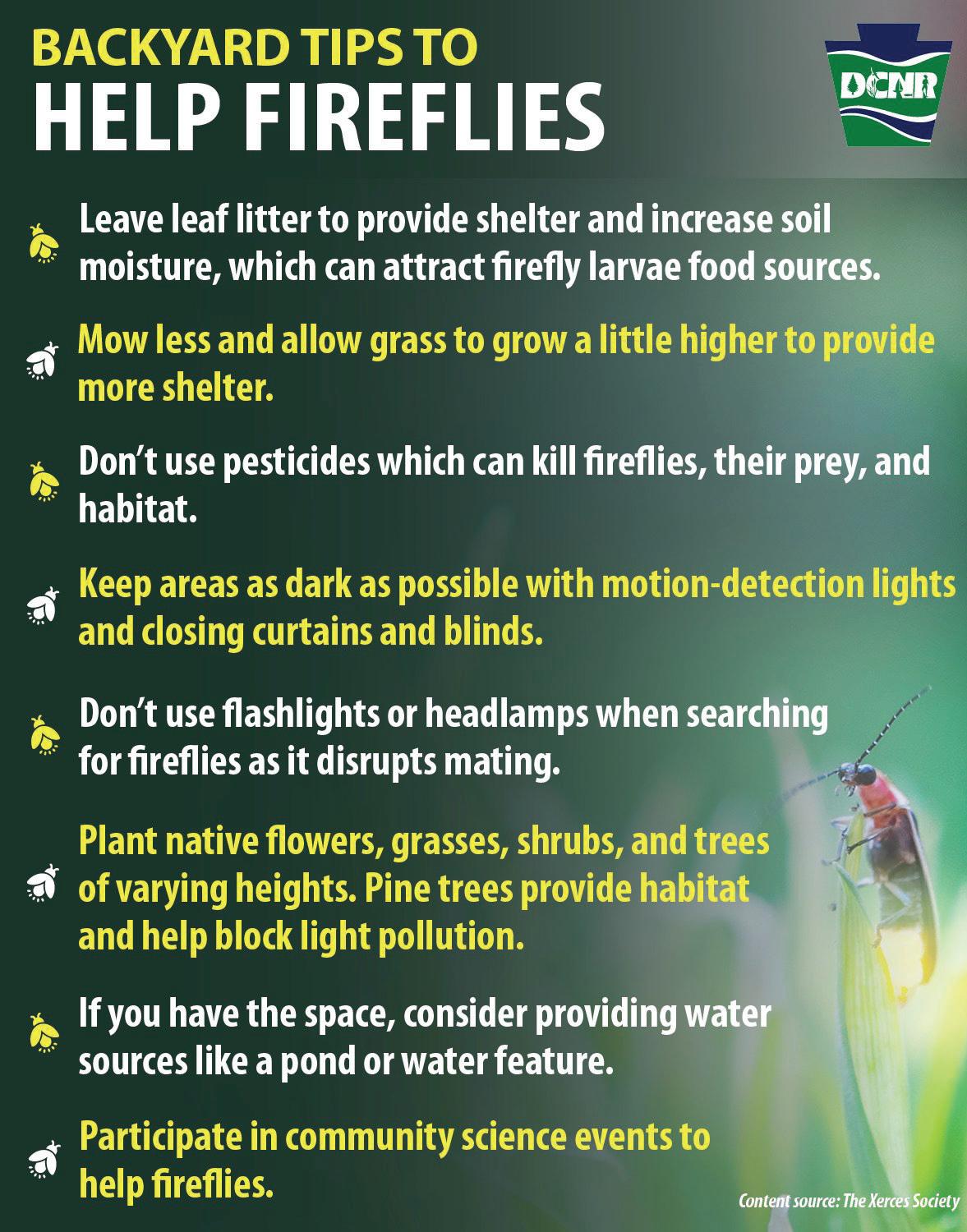
Late Blooming
THE SECRET TO AN ENDLESS SUMMER
Blake Goll, Nature Education Coordinator at Willistown Conservation Trust
THERE’S A CERTAIN WITCHCRAFT that settles into an autumn wildflower meadow. The ironweed and goldenrod create a dreamlike palette of deep hypnotic violet and harvest yellow, while brown seedpods add a cathartic nostalgia to the romantic cornucopia. In the September wind, swaying stems, quivering blooms and fluttering wings create the same serenity one feels gazing out onto an oceanscape.
Yet, unlike the ocean, in the meadow you’re surrounded by extraordinary winged animals everywhere you look. Even after gardeners have finished the season’s weeding, children have gone back to school, and beach bags have been stowed away, the energy of summer continues here.
Flashy goldfinches frolic across the meadow from one sunflower to the next, honeybees covered in pollen eagerly wriggle among the velvet petals of the mountain mint, and butterflies of myriad species—monarchs, fritillaries, sulfurs, buckeyes, skippers, swallowtails—dance with rapture around the profusion of aster blooms! Indeed, late September and October are the pollinator after-party, where the champagne of the aster takes center stage.
NATIVE PLANTS AND NATIVE INSECTS
Contributing in a meaningful way to this kind of biodiversity throughout the year and deep into the fall starts with mindful plant selection.
Although many plants available in garden centers and nurseries are beautiful, only native plants function well in our ecosystem’s food webs. This is ultimately because plants don’t want to be eaten. Consequently, plants have developed chemical defenses against the insects drawn to them, which in turn set in motion an arms race for the insects to develop ways around these defenses.
As a result of many years of evolution, our native insects specialize in targeting species of native plants. For example, a native oak tree can be used as a caterpillar host plant for 500 native species of butterflies and moths, although a nonnative gingko (native to China) supports only about five of our native insect species.
AND BIRDS
It follows then that a wildflower meadow filled with native perennials is a self-sustaining bird feeder filled with insects, a major food supply for most North American land birds. This is especially true in the summer when, for example, one pair of chickadees must feed their young up to 500 caterpillars a day. In September and October when some of the flowers are spent, finches and sparrows feast on the seeds to prepare for the cold weather ahead.



PHOTOS
Tiger swallowtail on garden

During the cooler months, billions of birds are migrating south and may stop to hunt insects and spiders in a wildflower meadow. And finally, during the winter the unmown wildflower meadow can provide nourishing seeds in an otherwise barren landscape for overwintering birds like dark-eyed juncos.
KALEIDOSCOPE OF WILDFLOWERS
Part of the joy of a wildflower meadow is the long-lived kaleidoscope of colors changing throughout the seasons and extending into fall. The show starts in mid-June with beardtongue, butterfly milkweed, and false sunflower creating a lively tapestry of white, orange and yellow. Common milkweed—a big whimsical ball of tiny pink flowers—also fluoresces at this time, luring many pollinators including the iconic monarch butterfly.
Late June is greeted with delicate sprays of white of the Virginia mountain mint, bright fuchsia of the purple coneflower and the fanciful blue petals of the curious spiderwort. July is the peak display with splashes of lavender of wild bergamot, dusty rose-colored Joe Pye weed and multi-colored garden phlox. Finally the robust August performers of asters, ironweed, trumpet honeysuckle and goldenrod do not tire until well into October, helping sustain migrant species like monarchs and ruby-throated hummingbirds.
A WILDFLOWER GARDEN
While this profusion of color and life is occurring aboveground, something marvelous is occurring below the earth. Native wildflowers spend the first couple of years developing impressive root systems that can stretch 8 to 12 feet underground, allowing them to mine groundwater. Compare that to your typical Kentucky bluegrass lawn— with roots barely reaching 6 inches— and you can see how much hardier native wildflowers are.
Even setting aside a few drifts on your property for wildflowers instead of lawn grass can substantially reduce your water usage. Mowing your wildflower patch is also necessary only once a year in early

spring. Leaving the wildflower growth during the fall and winter months provides habitat for overwintering birds, cocoons and other wildlife.
Not only are native wildflowers easy to care for, they’re also relatively easy to establish. Simply stop mowing a manageable sunny area of your property in the spring and tuck a thoughtful variety of landscape plugs into the ground among the existing lawn, each plug about one square foot apart.
The planted plugs may need occasional water at first if you notice wilting, but within a month or two their tough roots will be able to sustain the plants. Yearly weeding may be needed during the first few years until the perennials reach their full competitive size.
That’s all it takes.
As you wistfully take in those last sips of summer from the September air, look around your yard and think about where you could begin to enhance your garden with the unparalleled natural beauty of wildflowers. This time next year as the rest of your garden begins to rest, you could be

Spiderwort and false sunflowers in late June
reveling in your endless summer landscape of late blooming color and life. ♦
Willistown Conservation Trust, a nonprofit land trust that’s protected over 7,200 acres of wildlife habitat, scenic views and agricultural lands in the Willistown area, has a mission to inspire in people a lifelong love of the land through education. Its Rushton Farm bird banding station is open to the public through November and the one-acre wildflower meadow at the Trust headquarters is also open for viewing. 925 Providence Rd., Newtown Square. More at WCTrust.org.
Variegated fritillaries on aster in late September

Butterfly mlikweed in June

